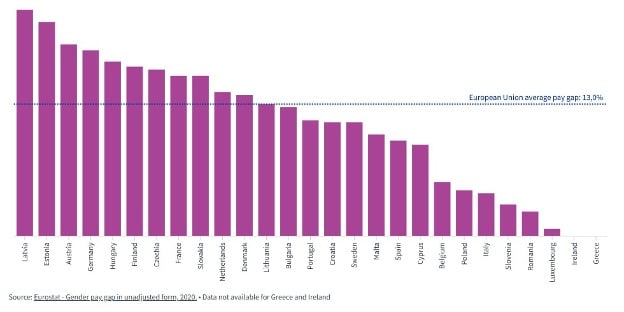.png?width=80&height=80&name=MicrosoftTeams-image%20(2).png) This blog is guest authored by Anita Lettink, Founder of HRTechRadar. Anita has worked with the largest global organisations to re-imagine the way work gets done, future-proof their people function and services, and ensure they are supported by the latest innovations and technologies.
This blog is guest authored by Anita Lettink, Founder of HRTechRadar. Anita has worked with the largest global organisations to re-imagine the way work gets done, future-proof their people function and services, and ensure they are supported by the latest innovations and technologies.
When someone asks, “How much do you earn?” what do you say? You might quote the amount mentioned on your payslip. Or you might politely decline to reveal your salary. It’s a sensitive question, shrouded in secrecy. But new pay transparency legislation changes that.
When we talk about equal pay, people often focus on the amount on their paychecks. When employees apply for another job, they compare their current salary to the new one to determine if they received a good offer. Only to find out later, once they had joined the new company, that their overall earnings did not increase. When you only look at your salary, that can be a costly mistake.
The reason: total compensation (or total rewards) is so much more than your salary. Benefits and rewards can translate into a considerable amount of money, even more so when bonuses or stock options are involved. In this article, we’ll discuss why it's crucial to look at total rewards when we design an initiative to achieve equal pay.
Compensation: The Pillar of Equal Pay for equal work is the foundation of a fair and just workplace. People should be rewarded equally for equal jobs, no matter their background or personal circumstances. Differences in compensation should be easily explained based on objective factors (education, experience, responsibilities, etc). When you prepare a pay transparency initiative, it's important to take a holistic view of total rewards, not just salaries.
This focus on transparency has a wider purpose than just achieving equal pay. It also enhances your image as an attractive employer:
- Inclusive Comparison: A comprehensive review of all the elements in the total rewards package ensures an accurate assessment of pay equality.
- Retention and Satisfaction: Employees are more likely to stay and be satisfied when they perceive their compensation as fair and competitive.
- Attracting Talent: A well-rounded compensation package is more likely to attract a diverse pool of qualified candidates.

The EU Gender Pay Gap
Data from the EU member states shows that women earn about 13% less than men on average. This (unadjusted) gender pay gap is caused by several factors: women often find themselves in lower-paying jobs and they shoulder a larger share of unpaid work. They also deal with obstacles accessing higher-paying roles. In addition, pay discrimination, where women receive less pay for the same or equal-value work, contributes to the gap. And it’s not just gender that negatively influences pay. You can repeat the same exercise for other protected categories like cultural background, disabilities, age, etc.

Nearly 70 years ago, the principle of equal pay was solidified in the foundational treaties of the European Union. Because the gender pay gap still exists, there's a renewed push to bridge this gap through the EU Pay Transparency Directive. This directive is designed to ensure that employers adhere to the principle of equal pay. Companies must share information about compensation, including an annual gender pay gap report (as of 2027 for companies with 150 employees and over). They must also take corrective measures if the gender pay gap exceeds 5%.
What does the EU Transparency Directive mean for you?
The European Pay Transparency Directive was adopted in June 2023, and member states will have three years to create the corresponding local legislation. Your first Gender Pay Gap report is due in 2027, meaning you must report over your 2026 workforce compensation data. The text of the directive is available in 24 languages, and I encourage you to read: it’s not long and will explain all you need to know.
When it comes to the definition of pay, the EU Directive includes a broad description of compensation. It includes any benefits in addition to the ordinary basic or minimum wage or salary that the worker receives directly or indirectly, whether in cash or in kind. And it includes bonuses, overtime compensation, travel facilities, housing and food allowances, compensation for attending training, payments in the case of dismissal, statutory sick pay, statutory required compensation, and occupational pensions.
Why can’t we just compare salaries?
Just looking at salaries alone to determine equal pay can be misleading or incomplete. I will give you three reasons, but the list can be much longer depending on your working conditions:
- Benefits and Bonuses: Compensation packages often include more than just a base salary. You might offer various benefits such as health insurance, retirement contributions, bonuses, stock options, and other rewards. These benefits can significantly affect the total value of an employee's compensation package.
- Job Roles and Responsibilities: Equal pay for equal work entails comparing job roles with similar responsibilities, requirements, and contributions to the organization. Solely comparing salaries without considering the scope and nature of the work can lead to inaccurate conclusions.
- Work Hours: Employees might have different work schedules, with some working full-time, part-time, or overtime. The total hours worked can significantly affect earnings and should be considered when evaluating equal pay.
The above examples apply to businesses in general. Depending on the nature of your business, you might also factor in location-based pay, experience and education premiums, performance-based pay, etc. This means that for a more accurate and holistic assessment of equal pay, it's necessary to consider the full range of compensation elements and not just the base salary.

What is Total Compensation?
Total compensation includes everything an employee receives from their employer, not just the salary and benefits. And they should all be considered, especially when we talk about workplace equity. Because it’s not only what you currently earn but also the potential opportunities you have access to:
- Base Salary: This is the contractual, fixed amount paid to employees for the work performed.
- Variable Pay: This includes bonuses, incentives, and other performance-driven rewards.
- Benefits: Essential elements like health insurance, retirement plans, paid time off, and other perks.
- Work-Life Balance: Flexible working hours, remote work opportunities, and a conducive work environment.
- Career Development Opportunities: The opportunity for growth and learning within an organisation.
If someone asked you to sum up all the compensation that each employee receives, how would you calculate that? Can you easily add all your benefits to that list? Or is that information scattered over a variety of HR systems?
Even though the first mandatory Gender Pay Gap reporting is due in 2027, it will use 2026 compensation data. That means you have two years to get ready. If you're just starting, I recommend you take action now while there is still time to bridge existing pay gaps before your first report is due. If only because establishing equal work for equal pay is the right and fair thing to do.